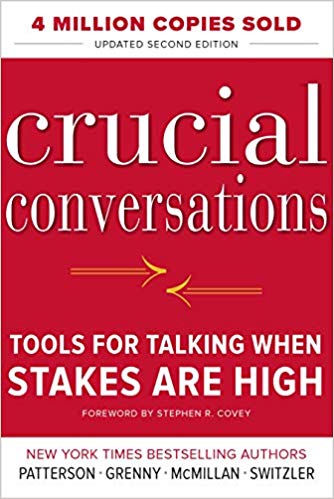

This article is an excerpt from the Shortform summary of "Crucial Conversations" by Kerry Patterson. Shortform has the world's best summaries of books you should be reading.
Like this article? Sign up for a free trial here .
What is the Crucial Conversations CRIB acronym? What does CRIB stand for, and what does it mean?
In crucial conversations, CRIB is a way to take a step back from the conversation when it goes off track. The Crucial Conversations CRIB technique can help you regain your footing, and create a path forward.
Make the Content Safe
We’ve all been part of conversations in which we didn’t feel safe to say what was on our mind. This article explains what to do to fix that. This is the Crucial Conversations CRIB technique, and the basic steps in brief are:
- Step away from the content of the conversation.
- Determine whether mutual purpose or mutual respect is at risk.
- Restore safety by restoring mutual purpose or respect (Use skills: apologize, contrast, rebuild mutual purpose; or, if you don’t already have a mutual purpose, create one using CRIB: Commit, Respect, Invent, Brainstorm).
- Rejoin the conversation: Return to the issue at hand.
Here’s a look at each step in detail.
Create a Mutual Purpose
Sometimes you end up in a debate because purposes differ. You could ignore the problem and push ahead, give up and let others have their way, or strike a messy compromise. However, the best approach is to back up and create a shared purpose by using four skills with the Crucial Conversations CRIB acronym: Commit, Recognize, Invent, Brainstorm.
C: Commit
Commit is the first part of the Crucial Conversations CRIB acronym. Commit to seeking a mutual purpose. Commit to staying in conversation until the parties come up with a purpose everyone shares. Give up your belief that your choice is the best — there may be a different choice that suits everyone. Verbalize your commitment to finding a shared purpose, even if someone else seems committed to winning. Your commitment builds safety so others can feel more confident and participate.
R: Recognize
Recognize the purpose behind the strategy: When you’re asking for something and the other person is asking for something else, you’re focused on strategy rather than what you really want. Refocusing on what you really want can help create a mutual purpose. With CRIB, crucial conversations can be seen as beneficial.
For example, one person wants to stay at home and the other wants to go out. These are strategies to achieve something else (a purpose that each person has). The two purposes are: to spend time together away from the kids; and to have some peace and quiet rather than running around. Their mutual purpose could be: Find something to do that is quiet and away from kids. With a mutual purpose, it will be easier to agree on a strategy.
You can break an impasse by asking, “Why do you want to do that?” Before you can agree on a mutual purpose, you need to know what people’s real purposes are. Step away from the content of the conversation, which is typically focused on strategies, and explore the purposes behind them.
When you separate strategies from purpose, new options become possible. When you focus on your real purpose you’re open to the idea of finding alternative strategies to serve everyone’s interests.
I: Invent
Invent a mutual purpose: If your goals and interests are completely at odds, you have to invent a mutual purpose. You do this by moving to more encompassing goals. For example, you and your spouse may disagree on whether you should take a promotion that requires moving to a new city. But you can agree on a larger goal: the needs of your relationship and family come before career interests. By focusing on bigger, longer-term goals, you can find ways to transcend short-term compromises that no one likes.
B: Brainstorm
Brainstorm new strategies: After finding shared purpose, return to dialogue and brainstorm strategies that address everyone’s needs. You’ll no longer get bogged down in conflict because you’ve committed to finding something everyone can support. And you’re free to think outside the box.
CRIB in Crucial Conversations is easy to remember and easy to use. It’ll help you stay focused on the conversation at hand and the bigger picture.
Tips for Creating Safety
When you’re in the middle of a crucial conversation, it can be hard to stay focused. Take a deep breath and remember the Crucial Conversations CRIB acronym. Then, keep the following in mind:
- Don’t get overwhelmed thinking you have to handle every heated conversation professionally. Aim for progress, not perfection. A little progress can have big benefits.
- Prepare by thinking about which skills will help you the most in an upcoming conversation (pick a few questions to use).
- Learn how to slow down when your adrenaline kicks in.
- Remember that you’ll get better with practice.
The Crucial Conversations CRIB technique can help you learn to create a better space for conversations, and ensure you and all other parties are on track to move the conversation forward. With CRIB, crucial conversations seem less daunting.

———End of Preview———
Like what you just read? Read the rest of the world's best summary of Kerry Patterson's "Crucial Conversations" at Shortform .
Here's what you'll find in our full Crucial Conversations summary :
- How to approach an argument without getting mad
- The mistakes most people make when trying to listen to someone else
- How to come up with win-win solutions that make everyone happy






